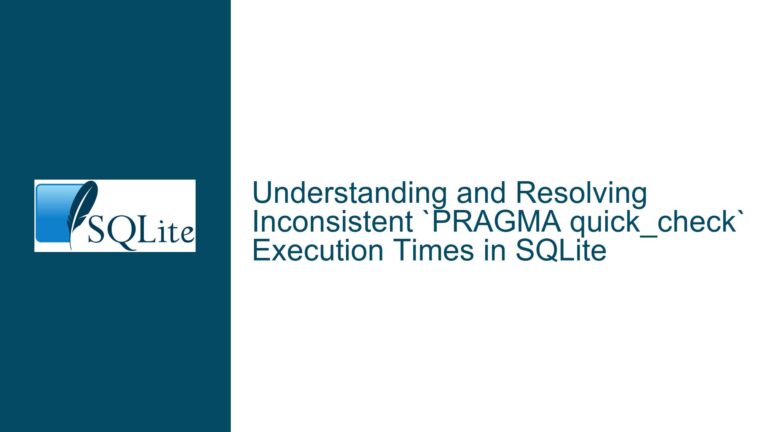Optimizing SQLite Access Strategies for Multi-Threaded HTTP Servers
Overhead and Concurrency in SQLite Connection Management
When designing a multi-threaded HTTP server that uses SQLite as its database backend, one of the most critical decisions revolves around how SQLite connections are managed. The choice of connection strategy can significantly impact the server’s performance, scalability, and reliability. The primary options include creating a new SQLite connection per HTTP connection, using a connection pool, or sharing a single connection across all threads. Each approach has its trade-offs, particularly in terms of overhead, concurrency, and resource utilization.
The overhead of opening fresh SQLite connections is non-trivial. Each new connection requires the database schema to be re-parsed, which can be computationally expensive, especially under moderate to high traffic conditions. This overhead makes the "one connection per HTTP connection" strategy less appealing for scalable systems. Connection pooling, where a fixed number of SQLite connections are reused across HTTP requests, mitigates this overhead by maintaining a set of pre-initialized connections. However, this approach introduces complexity in managing the pool and ensuring that connections are properly synchronized.
In serialized mode, SQLite allows multiple threads to share a single connection, but this comes with significant limitations. While serialized mode ensures thread safety by allowing only one thread to access the connection at a time, it effectively serializes all database operations, which can become a bottleneck under concurrent load. This mode is particularly problematic for read-heavy workloads, as it prevents parallel execution of read operations, even though SQLite inherently supports concurrent reads in other modes like WAL (Write-Ahead Logging).
The concurrency characteristics of SQLite are further complicated by the behavior of prepared statements. Prepared statements are tied to a specific connection and cannot be shared across threads without risking race conditions. For instance, if one thread resets a prepared statement while another is still using it, the application may crash or produce incorrect results. This limitation makes it challenging to implement a shared connection strategy without introducing additional synchronization mechanisms.
Thread Safety and Prepared Statement Handling in Serialized Mode
Thread safety is a paramount concern when using SQLite in a multi-threaded environment. SQLite offers several threading modes, including single-thread, multi-thread, and serialized modes. In serialized mode, SQLite enforces strict thread safety by allowing only one thread to access a connection at a time. This mode is the safest but also the most restrictive, as it serializes all database operations, effectively eliminating any potential for parallel execution.
In contrast, multi-thread mode allows multiple threads to use different connections simultaneously but requires the application to enforce thread safety for each connection. This mode can offer better performance for workloads that can be partitioned across multiple connections, but it places a higher burden on the developer to ensure that no two threads access the same connection concurrently.
Prepared statements add another layer of complexity to thread safety. A prepared statement is associated with a specific connection and cannot be safely shared across threads. If multiple threads attempt to use the same prepared statement concurrently, the results are undefined and likely to lead to crashes or data corruption. This limitation makes it difficult to implement a shared connection strategy without additional synchronization, as each thread would need its own copy of the prepared statement.
One potential workaround is to use a prepared statement cache, where each thread retrieves a prepared statement from a shared pool. However, this approach requires careful management to ensure that statements are properly reset and reused without causing race conditions. The Tcl API provides an example of such a cache, but implementing a similar mechanism in other languages can be challenging.
Implementing WAL Mode and Connection Pooling for Scalability
To achieve scalability in a multi-threaded HTTP server using SQLite, it is essential to leverage WAL (Write-Ahead Logging) mode and connection pooling. WAL mode significantly improves concurrency by allowing multiple readers to operate simultaneously while a single writer is active. This mode is particularly beneficial for read-heavy workloads, as it enables parallel execution of read operations without blocking writers.
Connection pooling complements WAL mode by reducing the overhead of creating and destroying SQLite connections. A well-designed connection pool maintains a fixed number of connections that are reused across HTTP requests, minimizing the cost of schema parsing and connection initialization. The size of the pool should be proportional to the number of CPU cores, typically in the range of 1.5 to 2 times the core count, to balance resource utilization and concurrency.
When implementing connection pooling, it is crucial to ensure that each thread has exclusive access to a connection while it is in use. This can be achieved by using a thread-safe queue or similar synchronization mechanism to manage the pool. Additionally, prepared statements should be associated with individual connections rather than shared across threads, to avoid race conditions and ensure thread safety.
In summary, the optimal SQLite access strategy for a multi-threaded HTTP server involves a combination of WAL mode, connection pooling, and careful management of prepared statements. By minimizing connection overhead, maximizing concurrency, and ensuring thread safety, this approach can deliver scalable and reliable performance for moderate to high traffic workloads.






